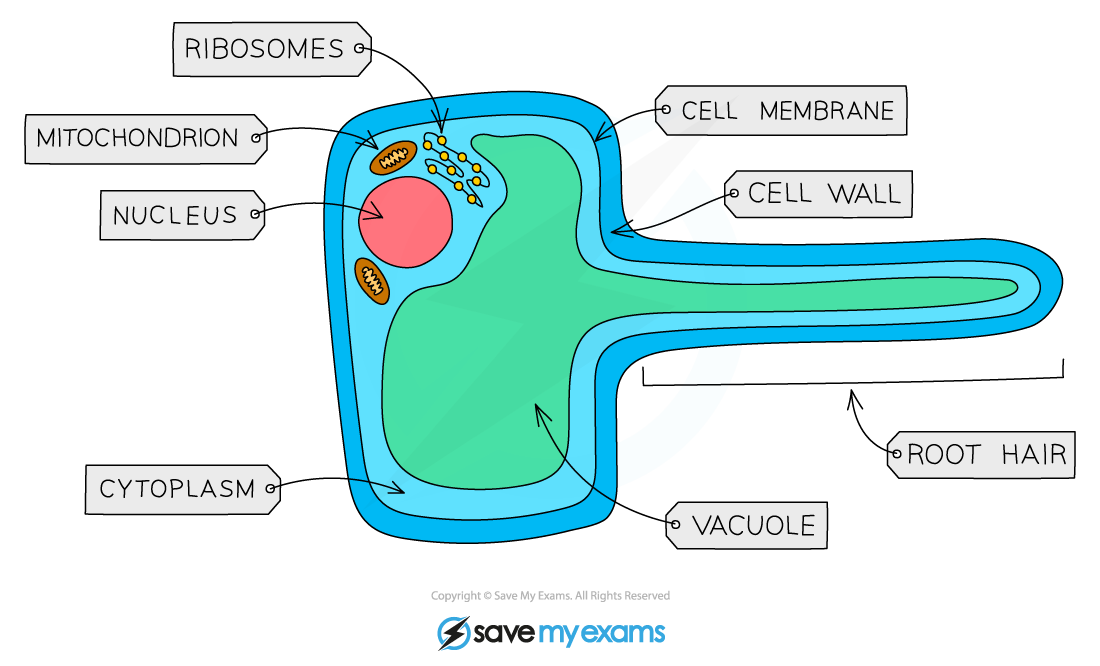Features of Exchange Surfaces (OCR A Level Biology) : Revision Note
Features of Exchange Surfaces
Effective exchange surfaces in organisms have a:
Large surface area
Short diffusion distance (thin)
Good blood supply
Ventilation mechanism
Across the Body Surface of a Single-celled Organism
Chlamydomonas is a single-celled organism that is found in fresh-water ponds. It is spherical in shape and has a diameter of 20μm. Oxygen can diffuse across the cell wall and cell surface membrane of Chlamydomonas
The maximum distance that oxygen molecules would have to diffuse to reach the centre of a Chlamydomonas is 10μm, this takes 100 milliseconds
Diffusion is an efficient exchange mechanism for Chlamydomonas
Increased surface area of root hair cells
Many exchange surfaces within organisms have adaptations that increase their surface area
A larger surface area provides more space over which the exchange of substances with the environment can occur
Root hair cells are specialised cells found in the roots of plants. They play an important role in the absorption of water and mineral ions from the soil
Root hair cells have a root hair that increases the surface area (SA) so the rate of water uptake by osmosis is greater (can absorb more water and ions than if SA were lower)

The root hair is an extension of the cytoplasm, increasing the surface area of the cell in contact with the soil to maximise absorption of water and minerals
Short diffusion distance in the alveoli
The exchange of oxygen and carbon dioxide occurs between the alveoli and the capillaries in the lungs
Oxygen and carbon dioxide are exchanged in a process of simple diffusion; (passive movement from high to low concentration)
The air in the alveoli contains a high concentration of oxygen. The oxygen diffuses from the alveoli and into the blood capillaries, before being carried away to the rest of the body for aerobic respiration
The blood in the capillaries has a relatively low concentration of oxygen and a high concentration of carbon dioxide. The carbon dioxide diffuses from the blood and into the alveoli and is then exhaled
The walls of the alveoli are only one cell thick and these cells are flattened
This means that gases have a very short diffusion distance so gas exchange is quick and efficient
Other features of the alveoli
Large number of alveoli
The average human adult has around 480 – 500 million alveoli in their lungs. This equals a surface area of 40 – 75 m2
The large number of alveoli increases the surface area available for oxygen and carbon dioxide to diffuse across
Extensive capillary network
The walls of the capillaries are only one cell thick and these cells are flattened, keeping the diffusion distance for gases short
The constant flow of blood through the capillaries means that oxygenated blood is brought away from the alveoli and deoxygenated blood is brought to them
This maintains the concentration gradient necessary for gas exchange to occur

The thin wall of the alveolus means that oxygen and carbon dixoide don't have to travel a large distance between the air in the lungs and the blood in the capillaries
Good blood supply in fish gills
In order for the diffusion of a substance across an exchange site to continue for a prolonged period of time, the concentration gradient must be maintained
An adequate blood supply helps to maintain a concentration gradient as it is continuously flowing, bringing substances that have just entered the blood away from the exchange site
Fish gills are adapted to directly extract oxygen from water as they have a large capillary network
The extensive capillary system that covers the gills ensures that the blood flow is in the opposite direction to the flow of water - it is a counter-current system
The counter-current system ensures the concentration gradient is maintained along the whole length of the capillary
Water with the highest oxygen content is found next to blood that is oxygenated
There is still a difference in concentration so diffusion of oxygen into the blood still occurs
Water continues to supply the blood with oxygen along the whole gill arch and ends with water with the lowest oxygen concentration adjacent to the most deoxygenated blood with continued diffusion occurring


Image showing the structure of fish gills and the counter-current system within gills
Ventilation mechanism in mammalian lungs
A ventilation mechanism also helps to maintain a concentration gradient across an exchange surface
Ventilation (mass flow of gases) in the lungs helps to ensure that there is always a higher concentration of oxygen in the alveoli than in the blood
The movements involved in breathing causes the air in the alveoli to change. Breathing removes air with low amounts of oxygen and high amounts of carbon dioxide and replaces it with air that has high amounts of oxygen and low amounts of carbon dioxide
Examiner Tips and Tricks
Make sure you can explain how adaptations allow for efficient gas exchange. They will either increase surface area, create a short diffusion distance or help to maintain the concentration gradient in some way!

You've read 0 of your 5 free revision notes this week
Sign up now. It’s free!
Did this page help you?
